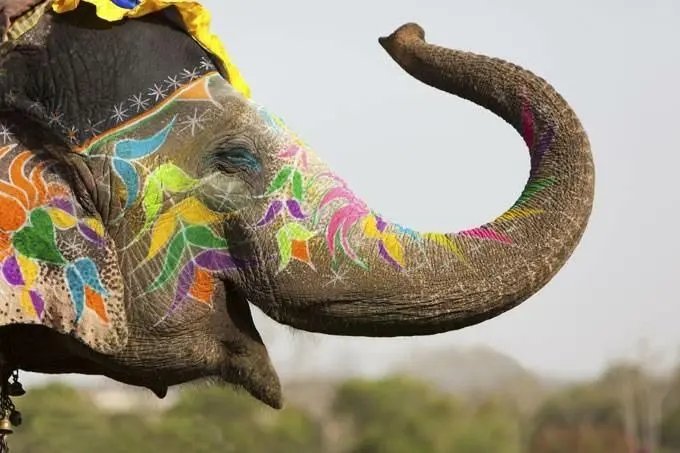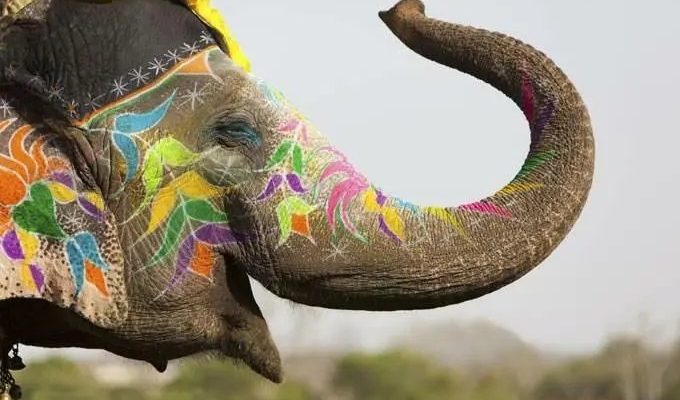
Let’s set the record straight and dive into some common myths surrounding the Indian elephant. By peeling back these layers of misunderstanding, we can appreciate these majestic animals for who they truly are. So, grab a cup of coffee, settle in, and let’s explore the fascinating world of the Indian elephant!
The Myth of the Size: Are Indian Elephants Smaller?
One of the biggest misconceptions is that Indian elephants are smaller than African elephants. Sure, they are often portrayed as the “smaller siblings” of their African counterparts, but here’s the thing: Indian elephants can actually grow to be pretty large!
While African elephants can reach heights of about 11 to 13 feet, Indian elephants typically stand anywhere from 6 to 11 feet tall. That might sound small in comparison, but keep in mind that size has its own scale! Indian elephants can weigh between 5,000 to 11,000 pounds. So, while they may not be as towering as African elephants, calling them “small” is like saying a tiger is just a big domestic cat—they’re impressive in their own right.
Additionally, Indian elephants have distinct features like smaller, rounded ears and a smoother skin texture, which can mislead people into thinking they are less robust. But remember, beauty comes in all shapes and sizes, and Indian elephants carry a grace that’s all their own.
Myth
Another common myth is the belief that Indian elephants are inherently aggressive. This stereotype might come from movies or stories where elephants are depicted as raging beasts, but in reality, their behavior largely depends on their environment and treatment.
Like any wild animal, elephants can display aggressive behavior when they feel threatened or cornered. However, most elephants, including Indian elephants, are generally social and gentle creatures. They live in strong family units and display a range of emotions, from joy to grief. Honestly, it’s fascinating to watch them interact—elephants often comfort each other during tough times, showing compassion just like humans do.
It’s also important to note that human activities, such as habitat destruction and poaching, can push elephants into defensive behaviors. So, instead of labeling them as “aggressive,” we should focus on understanding their needs and protecting their habitats to minimize conflicts.
Elephants Don’t Forget: The Truth Behind Their Memory
You might have heard that elephants have incredible memories, right? While that’s somewhat true, there’s a myth that they never forget. This idea might be romantic and dramatic, but it’s not entirely accurate.
Elephants do have impressive cognitive abilities that allow them to remember locations, recognize other elephants, and even recall past experiences. For example, female elephants often have strong bonds with family members and can recognize their relatives even after years apart. But let me explain: their memory is a tool for survival.
They need to remember where the best water sources are or which areas to avoid due to danger. But, like all creatures, their memories are not infallible. They can forget certain details or experiences over time, just like we do. So, while elephants are wise and have remarkable memories, saying they never forget is pushing it a bit too far.
Myth
It’s widely known that elephants are herbivores, but the myth that they only eat grass or leaves is quite misleading. Indian elephants have a varied diet that goes beyond your average salad bar.
In the wild, they consume a wide range of plant materials, including fruits, bark, and even agricultural crops. Their favorite foods can include bananas, sugarcane, and even the leaves of certain trees. In fact, they can eat up to 300 pounds of food in a single day! That’s a lot of munching!
Additionally, elephants will sometimes engage in “browsing” or “grazing” depending on their surroundings. If they come across crops growing in a farmer’s field, their natural instinct might lead them to take a snack. This behavior, while sometimes troublesome for humans, is simply part of their diverse diet. It’s essential to understand their eating habits in context to foster coexistence with local communities.
The Myth of Taming Elephants: Are They Just Pets?
Many people have this image of elephants being “tamed” and treated like pets. While some elephants are trained for specific tasks, like working in tourism or logging, the reality is far more complex.
Indian elephants can be trained to a certain degree, but taming them completely is a challenging and often detrimental goal. Elephants are wild animals with unique social structures and needs that cannot be replicated in a domestic setting. Training usually involves a process called *gundruk*, where the elephant learns commands through repetition and rewards.
However, this doesn’t mean they become our pets. Instead, they often end up facing harsh conditions and inadequate living situations. Promoting the idea of elephants as mere pets undermines their intrinsic value as magnificent wild animals. It’s essential to respect their wild nature and advocate for their protection in their natural habitats.
Conservation Myths: Are Elephants Endangered?
Some folks believe that Indian elephants are not endangered, thinking they’re just fine in the wild. However, the reality is quite different. The Indian elephant population has been significantly declining due to habitat loss and poaching.
While there are conservation efforts in place, such as protected reserves and wildlife sanctuaries, the threats to their survival persist. It’s estimated that there are only about 27,000 to 31,000 Indian elephants remaining in the wild today, categorized as “Endangered” by the International Union for Conservation of Nature (IUCN).
Conservation organizations work tirelessly to protect these elephants and their habitats through awareness campaigns, anti-poaching efforts, and community engagement. Being aware of their endangered status is crucial in fostering public support and ensuring a future for these majestic creatures.
Final Thoughts: Understanding and Protecting Indian Elephants
As we wrap up our exploration of these common myths and misconceptions about the Indian elephant, it’s clear that understanding them requires a bit of unpacking. These gentle giants deserve our respect and admiration, not just for their size but for their intelligence, emotion, and social structures.
By dispelling myths and promoting accurate knowledge about Indian elephants, we can work towards better conservation efforts and coexistence with these magnificent animals. So, the next time you encounter an elephant—whether in person or through a story—remember the truths we discussed today. Let’s appreciate and protect these incredible beings to ensure they roam the Earth for generations to come!

